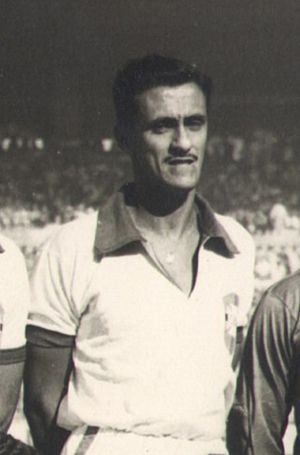Danilo Alvim facts for kids

Danilo Alvim with the Brazil national football team in the 1950 FIFA World Cup
|
||||||||||||||||||||||||||||||||||||||||
| Personal information | ||||||||||||||||||||||||||||||||||||||||
|---|---|---|---|---|---|---|---|---|---|---|---|---|---|---|---|---|---|---|---|---|---|---|---|---|---|---|---|---|---|---|---|---|---|---|---|---|---|---|---|---|
| Full name | Danilo Alvim Faria | |||||||||||||||||||||||||||||||||||||||
| Date of birth | 3 December 1920 | |||||||||||||||||||||||||||||||||||||||
| Place of birth | Rio de Janeiro, Brazil | |||||||||||||||||||||||||||||||||||||||
| Date of death | May 16, 1996 (aged 75) | |||||||||||||||||||||||||||||||||||||||
| Place of death | Rio de Janeiro, Brazil | |||||||||||||||||||||||||||||||||||||||
| Position(s) | Defensive midfielder | |||||||||||||||||||||||||||||||||||||||
| Senior career* | ||||||||||||||||||||||||||||||||||||||||
| Years | Team | Apps | (Gls) | |||||||||||||||||||||||||||||||||||||
| 1939–1942 | America-RJ | |||||||||||||||||||||||||||||||||||||||
| 1943 | Canto do Rio | |||||||||||||||||||||||||||||||||||||||
| 1944–1945 | America-RJ | |||||||||||||||||||||||||||||||||||||||
| 1946–1954 | Vasco da Gama | |||||||||||||||||||||||||||||||||||||||
| 1955–1956 | Botafogo | |||||||||||||||||||||||||||||||||||||||
| International career | ||||||||||||||||||||||||||||||||||||||||
| 1945–1953 | Brazil | 25 | (2) | |||||||||||||||||||||||||||||||||||||
| Managerial career | ||||||||||||||||||||||||||||||||||||||||
| 1956–1957 | Uberaba | |||||||||||||||||||||||||||||||||||||||
| 1963 | Botafogo | |||||||||||||||||||||||||||||||||||||||
| 1963–1965 | Bolivia | |||||||||||||||||||||||||||||||||||||||
| 1968–1970 | Remo | |||||||||||||||||||||||||||||||||||||||
| 1978 | Náutico | |||||||||||||||||||||||||||||||||||||||
| 1981 | Galícia | |||||||||||||||||||||||||||||||||||||||
|
Medal record
|
||||||||||||||||||||||||||||||||||||||||
| *Club domestic league appearances and goals | ||||||||||||||||||||||||||||||||||||||||
Danilo Alvim Faria (born December 3, 1920 – died May 16, 1996) was a famous Brazilian football player. He was known for his elegant style and great ball control. People called him "Prince" because of how gracefully he played.
Danilo was a key player in the Brazilian squad that played in the 1950 FIFA World Cup. He was considered one of the best defensive midfielders in the world during his time.
Playing for Clubs
Danilo Alvim started his football journey as an amateur player. He played for a team called America-RJ. In 1941, a famous coach named Flávio Costa saw him play. Danilo was asked to join the coach's team for practice.
He impressed the coach so much that he was invited to join the main squad. On his way home, celebrating the news, he had an accident. He was hit by a car and broke his leg.
In 1942, Danilo returned to America-RJ. The team decided to send him to Canto do Rio to save money. There, he helped Canto do Rio win a championship in Rio de Janeiro.
Because of his success, he was quickly brought back to America-RJ. He also rejoined the Rio de Janeiro state team. In 1946, Danilo joined Vasco da Gama.
He became a very important part of the "expresso da vitória" (victory express) team. This team was one of Brazil's best club teams ever. They were the first Brazilian club to win an international title. This was the South American club championship in 1948. This competition was played before the Copa Libertadores started.
Danilo finished his playing career with Botafogo. He was always remembered for his elegant and skillful way of playing.
Playing for Brazil
Danilo played 25 games for the Brazilian national team. He scored 2 goals between 1945 and 1953. He helped Brazil win the Copa América in 1949.
He was a starting player for the famous 1950 World Cup team. This team is often remembered for losing the final game. Brazil only needed a draw against Uruguay to win the 1950 FIFA World Cup. The game was played at the huge Maracanã stadium.
Uruguay came back from being one goal down to win the match 2-1. This defeat is known as the Maracanaço. It was a very sad day for Brazilian football fans.
Even with that loss, Danilo is still seen as one of Brazil's most complete defensive midfielders. Many people think he is among Brazil's top 10 greatest players. Like other great players from the 1950 team, his legacy might be even bigger if not for that one game at the Maracanã.
Becoming a Coach
After he stopped playing football, Danilo became a coach. He later shared that his leg injury from the car accident meant he could never fully straighten or bend his right leg again.
In 1963, he coached the Bolivia national team. He led them to win their only Copa América title. They won by beating Brazil 5-4 along the way.
Danilo was the first coach not from South America to win the Copa América since Jack Greenwell in 1939. Greenwell had coached Peru to victory.
See also
 In Spanish: Danilo Alvim para niños
In Spanish: Danilo Alvim para niños

